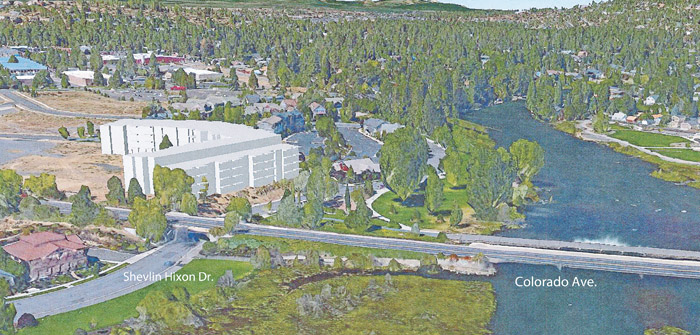(Photo: Proposed Apartment Complex | Photo courtesy of Mike Walker)
Last Thursday, Bend’s hearing officer held a public hearing for a 170-unit apartment proposal located near the center of Bend. Supporters and opponents filled all the available chairs, sat on the floor and overflowed into the hallway. What was so special about this proposal that drew this kind of attendance? This was not your typical local neighborhood standing in the way of growth. A portion of the community recognized that this proposal would affect them.
In one corner of this donnybrook is the Brooks Resources Corporation (landowner) and Evergreen housing Development (project developer). They seek approval of a five-story apartment building sandwiched between the Pavilion ice rink and the Deschutes River’s McKay Park. This building represents the “VMT Vison” for future housing in the center of Bend, which is a critical piece of the 2016 Comprehensive Plan. Tall, high-density, multi-family buildings are assumed to allow residents to work, plan and reside in a small radius that the city’s computer modeling found minimizes the vehicle miles traveled (VMT), the performance measure favored by the state and was instrumental in winning state approval of the Urban Growth Boundary (UGB) expansion completed in 2016. This building seems just what the city planners had in mind when they began their campaign years ago for the VMT Vision for Bend’s future.
In the other corner is a coalition of local neighbors and the community at-large who use these two popular parks, or commute through this neighborhood on Colorado Avenue and Simpson Avenue — two important city arterials. This coalition represents the “Livability Vision” of Bend which places a high value on “livability.” The coalition opposed this project on a large number of issues including — but not limited to — traffic congestion, parking shortage, building height and building scale.
The four-way stop at Columbia Avenue and Simpson Avenue currently experiences long delays and vehicle stacking can extend eastward, all the way to the Simpson/Colorado roundabout. As traffic increases, this roundabout would experience gridlock which bottles up all movements at a roundabout. Meanwhile, the staff report only recommends a payment of $56,000 prior to issuance of occupancy. The coalition objected this condition because no schedule is set for the construction of a roundabout to solve the problem. The staff condition kicks the can (solution) down the road. How long would the community have to put up with this failure?
The coalition believed the apartments’ parking needs would greatly exceed the site’s proposed parking supply and force tenants to find their parking in the neighborhood streets, including the only parking available for McKay Park, or trespass in neighboring businesses including the ice rink.
The coalition opposed the tall, five-story building request to exceed the allowed building height limit. From the street in front of McKay Park, the building towers overhead by about 70 feet which is about the same height as Franklin Crossing, the tallest downtown building. The visual scale of the proposed building dwarfs the surrounding buildings, McKay Park and casts a shadow over the entire width of the Deschutes River. The master plan for this area had intended the building to be 40 feet further away from the park and built into the slope instead of on top of the slope.
At ring side, some score keepers gave this round to the Livability Vision coalition. However, the score keeper that matters (hearing officer) won’t make his decision until the process is completed. A second hearing is set for Friday from 3pm to 6pm at City Hall. The hearing officer musts rely exclusively on “applicable criteria.” Normally, the applicable criteria is limited to the Bend Development Code (BDC), but here is an important twist.
Bill Smith, the man behind the development of the Old Mill District, spoke about his long struggle to win state approval of its unique zoning and the master plan that set the mold for this area by creating another layer of development standards. The master plan standards are additional applicable criteria. The master plan’s intent was the, “creation of a stimulating, attractive, mixed-use environment through the use and inter-relationship of open spaces, building locations, building scale and design and pedestrian amenities,” which is not a bad description of “livability.” The applicant thought they could wave their magic wand and simply say their proposal complies with the master plan. The staff report neglected to consider the applicable criteria of the Shevlin Center Master Plan. For example, the master plan’s Covenants, Conditions and Restrictions states, “Adequate off-street parking shall be provided to accommodate all parking needs for employees, visitors, and company vehicles on site. The intent of this provision is to eliminate the need for any on-street parking.”
The results of the public hearing won’t be known for many weeks. The door is open for a possible win for the Livability Vision over the VMT Vision because the existence of the City-approved 1997 master plan.
While waiting for the rest of the story to unfold, let’s take a closer look at these two visions.
The Livability Vision stands for those who don’t want traffic to come to a standstill. They don’t want to conduct intensive searches for parking space to shop, go to work or even struggle to find a space near their residence. They don’t want to become a scaled down version of Portland.
The VMT Vision counts on less driving, but let’s test whether this goal will ever be realized. Documentation exists that implies; 1) the tall building needs vacant land, 2) very few vacant parcels exist in the center of Bend, 3) the few vacant parcels are very expensive, 4) most Bend employees don’t qualify for these tall buildings, 5) most Bend employees commute to Bend, 6) State of Oregon defines the VMT as only those trips that begin and end in the city and 7) more Bend employees will need to commute. This is a sad future when you consider a majority of Bend employees already commute. Who will live in the tall buildings? Most new migrants to Bend are retirees, and will they want to live in 600-700 square foot studios and one-bedroom units? Perhaps.
The community shouldn’t be too sad if this project is denied. The VMT Vision seems destined to build a future for only wealthy retirees and more employees are priced out. Are the politicians brave enough to look at the data which suggests their comprehensive plan is not achieving the desired results, or will they shield their eyes and cover their ears while continuing to campaign for housing plans that seems to fail to deliver a balanced community. Failure of tall buildings to deliver the goods will be a bitter pill to swallow for the many supporters of these tall mixed-use buildings.
Meanwhile, what do you tell yourself when your children figure it out first and move to communities with more opportunities?
Mike Walker is a civil engineer with over 40 years of experience in land development.




